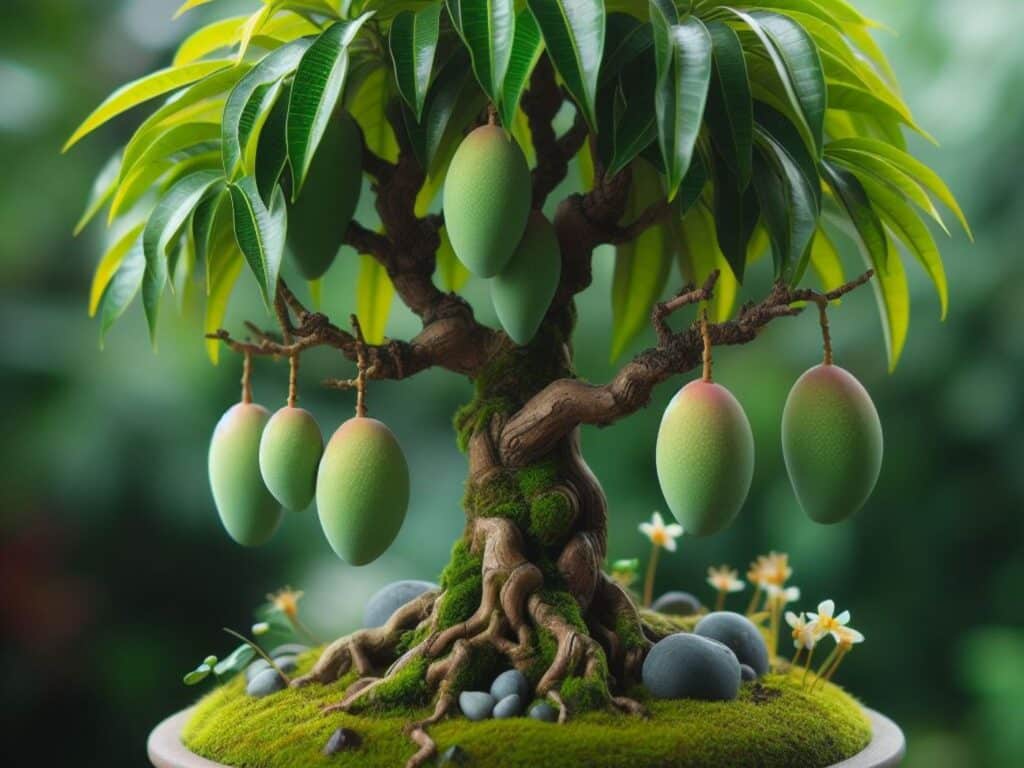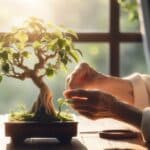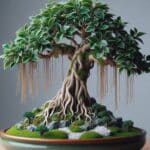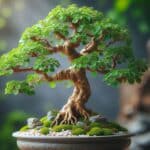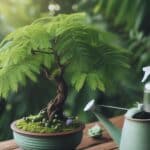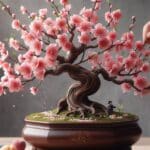If you love bonsai trees and fruit trees, try growing your mango bonsai tree (Mangifera Indica).
These tropical evergreen trees can add great interest to your garden spaces with their slender leaves and sweet flower fragrance. If you take good care of your tree, it will also bear fruit.
It is a lot of fun to see these tiny trees produce fruit, and there is nothing more rewarding than being able to pick and eat the sweet fruits that your miniature tree has.
Mango bonsais are easy to grow and care for. In this guide, we will show you how to grow mango bonsai and take good care of this type of beautiful tree.
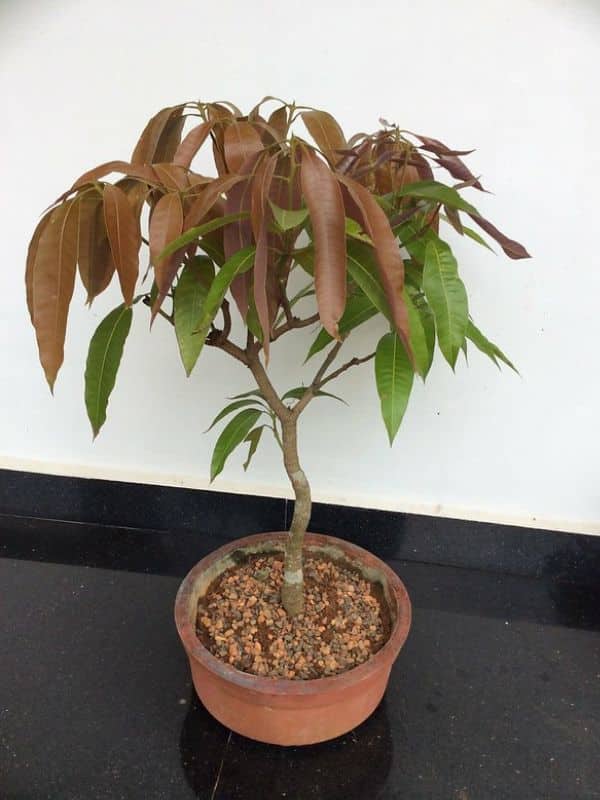
Plant Facts
| Scientific name | Mangifera Indica |
| Common names | Mango Bonsai Tree, Magnifera, Mango |
| Family | Anacardiaceae |
| Plant Type | Fruit Tree, Bonsai Tree |
| Height and Width | 98 – 131 ft. tall (natural), 6 – 15 ft. tall (bonsai) |
| Origin | Originates from India but grown in any tropical area |
| Flower colors | White, yellow, pinkish, or reddish flower spikes |
| Foliage color | Bright to dark green |
| Sun Exposure | 8 Hours of Direct Sun |
| Soil Type & pH | Well-drained, lateritic, alluvial, sandy loam, or sandy soil with a pH range of 5.5 – 7.5 |
| Special features | Low Maintenance. Good for Containers. Bears edible fruits. |
What Does a Mango Bonsai Tree Look Like?
A mango bonsai tree looks very similar to an adult mango tree. It is a lot smaller and grown in a shallow pot. Even though the foliage and stem of this tree are miniaturized compared to a fully grown mango, it bears fruit with the same proportion as a regular mango tree. These small trees do, however, bear fewer fruits since the tree is smaller and these types of trees usually have fewer branches.
Where Do Mango Trees Grow?
Mango trees originate from India, but they are currently grown in regions with tropical or warmer subtropical climates across the globe. These plants typically only grow in tropical and warm areas because they are susceptible to frost and prefer higher humidity levels.
Bonsai mango trees are also grown in tropical and humid climates, and it is best to keep them outside where they will receive plenty of direct sunlight. In winter, these trees can be positioned indoors in a sunny window so they will be protected from frost.
How to Grow a Mango Bonsai Tree

Mango bonsai trees are relatively easy to grow or care for. They are suitable for bonsai creations because they can grow well in containers. Let’s look at the best way to grow your bonsai mango tree.
Propagation
It is usually best to start your mango bonsai from seed or to get a young sampling from a local nursery.
If you are growing the mango fruit tree from seed, you should get a healthy one. Buying a good mango seed can be difficult, but you can use it from a ripe mango fruit.
It is best to germinate the seed when you extract it from the fruit. In many cases, you might even see that the seed has already started germinating inside the fruit.
Place your seed inside a plastic container with some damp cotton. Keep the plastic bag or container slightly open so the seed can breathe. Position in a dark and warm environment until the seed starts to sprout.
Next, you can plant the seed in enriched garden soil. Plant it about one inch below the soil surface and place the pot in a warm, moist place with lots of indirect light.
Water the seed regularly. You should see the sprout emerge from the soil about 2 – 4 weeks after planting it.
Allow the sapling to grow for about 6 months. Mango trees typically grow straight upward. You can top the tree top if it reaches a desirable height to encourage some branching.
Soil
Mango trees grow best with a soil pH level of about 5.5 – 7.5 and they can be planted in good quality potting soil with some crushed gravel at the bottom for proper drainage. Any good potting soil should be just fine for a young sapling.
Once you transplant your bonsai mango tree into a bonsai container, it is usually best to use bonsai soil mixtures.
Pruning and Training
A mango tree should be pruned to encourage more branching and to help it develop bushier growth. Start by trimming off the top of the tree. This will encourage more branching. Keep branches suitable for a bonsai shape and remove any branches that grow inward or might intervene with your tree’s desired shape.
If it is time to prune your bonsai to maintain its shape, you can start by cutting off dead, damaged, and entangled branches. This will encourage air circulation and promote growth.
The branches of bonsai plants can be modified through wiring techniques. Wrap copper or aluminum wire around branches that you would like to modify. Bend these branches into a desired shape or use guy wires to shape some of the branches downwards. The wires should be removed after about 1 – 4 months before they start cutting into the bark of your tree.
When the tree starts to flower, you must pinch back some mango fruits. Too many fruits can affect the health of your little tree.
Repotting and Transplanting
When the mango seedling reaches a desired height, you can transfer it into a more suitable bonsai container. A suitable container can greatly boost the overall appearance of bonsai trees.
Select a container slightly larger than the mango bonsai tree’s root system. It is also best to choose a deep-seated pot so the roots can grow deeper. You will need a pot with enough drainage holes to drain appropriately.
Before transplanting the bonsai tree, removing about one-third of the tree’s root system is usually recommended.
Place the tree inside the new container and use a quality bonsai soil mixture this time.
A bonsai mango tree should be repotted once every two to three years, and it is usually best to select a slightly bigger container with each transplant.
How to Care for Mango Bonsai Trees

After planting and shaping your miniature mango tree, you will need to take good care of it. Let’s take a look at the best way to care for this tropical mini tree.
Water
Manto trees usually prefer lots of moisture. They need to be watered frequently but the container should drain properly because these fruit bonsai trees can develop root issues in waterlogged conditions.
Watering bonsai can be reduced a little bit when the tree reaches maturity around 2 – 3 years after germination. You can also reduce watering when the tree starts developing fruit. Wait until your tree is 40 – 50% into its bloom cycle before you start cutting back on watering.
Sunlight
These small trees need plenty of direct sunlight to grow well. Your young plant should receive about 8 hours of uninterrupted sunlight to develop fruit and stay healthy. This evergreen bonsai also needs lots of direct sunlight during winter.
Temperature and Humidity
Msnago trees are tropical plants that prefer warm weather. They grow best at temperatures over 40 degrees F and will need protection during frosty weather. These trees also love lots of humidity. If you are keeping them indoors during winter then you should position a humidity tray next to them or use a humidifier to raise the humidity levels.
Fertilizer
All bonsai trees need to be fertilized regularly but they are extremely sensitive to fertilizer burn. The best way to fertilize your tree is by using an organic fertilizer water. You can also use composted manure or fish emulsion to fertilize your little tree.
If you want your tree to bloom vigorously or produce delicious fruit then you should add a little bit of citrus fertilizer in the spring season when the tree starts to bloom.
Pest and Diseases
Mango bonsai trees should be regularly inspected for pests or diseases because these types of problems can hinder your tree’s growth. Here is a quick look at some of the most common pests for these types of fruit trees.
Powdery mildew
Powdery mildew is a fungus that appears in the form of light grey or white powdery spots on the leaves. It can be treated by spraying a mixture of baking soda, liquid soap, and water onto the leaves or with a fungicide.
Anthracnose
This term refers to a group of fungal diseases that cause dark lesions on the leaves, stems, and twigs of your plant. It is best to prune out all affected leaves and spray the plant with a copper-based fungicide.
Scabs
Scabs will form yellow spots on the leaves that can turn into dark olive-colored spots on the leaves and stem. This type of velvety fungal growth can cause a lot of damage to the leaves. Fungicides can help combat this issue.
Spider Mites
Spider mites live on the underside of leaves and spring protective silk webs. These sucking pests can cause malformations in your young plant. You can treat your mango bonsai with an insecticide or gently wash the foliage with a soft cloth and a mild mixture of water and dish detergent.
Common Varieties or Cultivars of the Mango Plant
There are many different varieties of mango trees, and most can be successfully used to grow a bonsai tree. Here is a quick look at some of the most common mango species ideal for growing a miniature mango tree since they grow well in containers.
- Dwarf Hawaiian
- Irvin
- Nam Doc Mai
- King Thai
- Carrie
- Coggeshall
- Neelam
- Glenn
- Amrapali
Conclusion
A mango bonsai can add a lot of charm to your garden and it is ideal for people with limited space who might want to farm fruits. These are ideal plant species to keep if you live in a warm and tropical area.
The little trees are pretty easy to grow and care for. They are also relatively easy to train or shape and perfect for a bonsai beginner who might be looking for something relatively easy to grow.
We hope that you enjoyed our guide and that you will have a lot of fun growing your own mini mango bonsai tree.
Up next: Growing and Caring for a Pear Bonsai Tree (Pyrus Communis)

